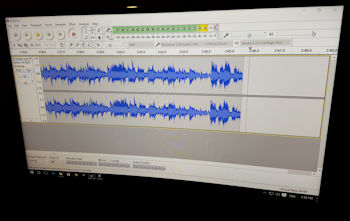Over a period of time all my CDs have been ripped and stored in my digital music library situated in a NAS and neurotically backed up in triplicate.

From deck to screen. Recording in action
But the recent loan of an LP from a friend encouraged me to look into transcribing it to digital files. It was a task which turned out to be much simpler and more rewarding than I expected.
Of course, you do need an amount of equipment and software to achieve this goal.
In a nutshell, from analogue source to digital file, this was my route.
I used my regular turntable, a Project Classic, and cartridge, an Ortofon 2M Blue, which feeds a Project Phono Box USB Phono Preamp. Fortunately, many years ago, I had the foresight to get a pre-amp with a A-D converter and USB port as well as the usual RCA outputs.
The USB output is connected to my PC which is the hub of my music system. The PC recognises the USB pre-amp as a microphone for the benefit of recording.
For recording software I downloaded an application called Audacity, which is open-sourced and free, a major thumbs up. The software immediately identified the USB input as a microphone device. Easy!

Live screen shot of Audacity in action
Audacity has a multitude of adjustments and other widgets can be loaded in, but I just used the base settings and achieved excellent results.
Once once you’ve made the recording you need to export it as an audio file. In this case I chose the .WAV codec, but it could have been any of the usual formats. There is also a facility to save as an Audacity Project, which I did, but have no idea what the usefulness of this is at the moment.
The quality of the recording was very good. The LP was in very good condition so there were minimal surface noises. There are widgets and filters available which minimise the cracks and pops sometimes found on LPs, but I decided not to use them in this case. They might be useful on worn and damaged LPs.
And that was it. I’m going to use the software to trim the lead-ins and lead-outs. It is also possible to split the files into individual tracks, although, I think, in this case I’m not going to. I still like the idea that listening to a long playing record is, at least, a twenty minute commitment to music.

